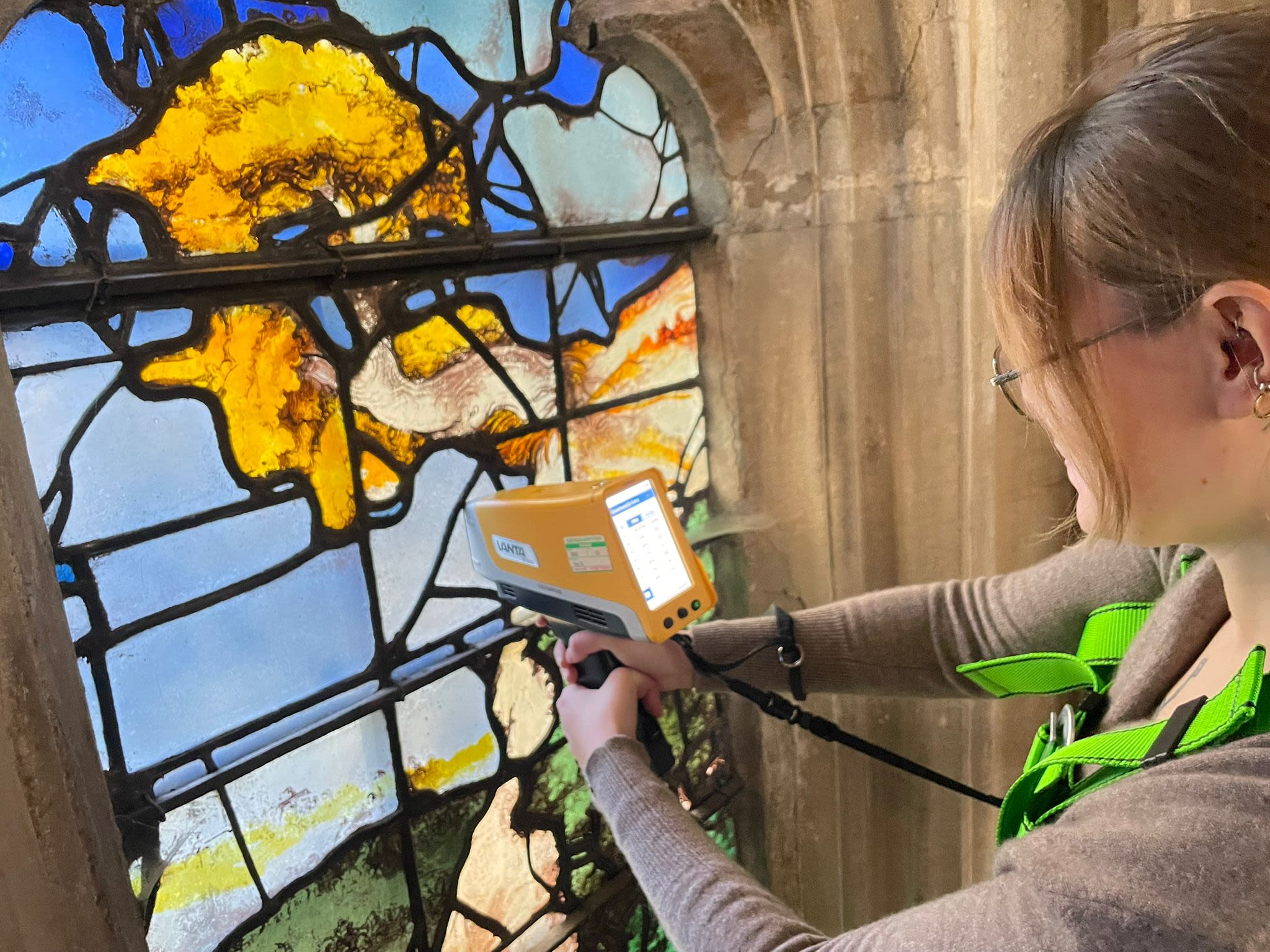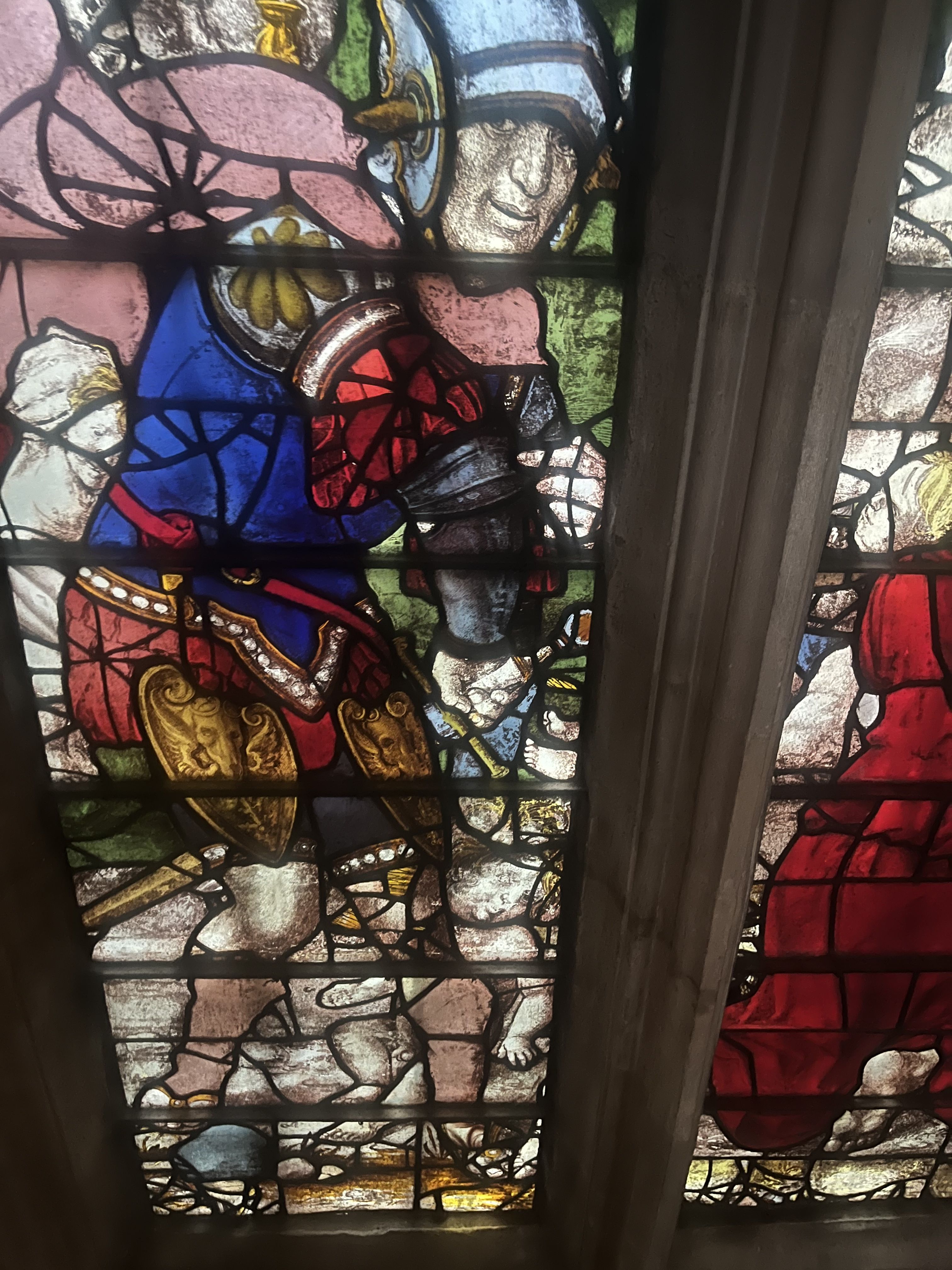Between Tradition and Innovation: Unveiling the Secrets of King’s College Chapel’s Stained Glass

The stained-glass windows of King’s College Chapel, Cambridge, are among the most celebrated in the world. Their intricate designs and radiant colours showcase the height of late medieval craftsmanship, yet the story behind their creation remains only partly told. These extraordinary windows, produced during a time of artistic and technological transition, offer a unique lens through which to explore the evolution of glass-making in England.
The project "Between Tradition and Innovation (BTI): The Evolution of Glass-Making at King’s College Chapel", spearheaded by Agnese Benzonelli and Caroline Goodson, seeks to investigate the earliest windows crafted by Barnard Flower, the Flemish glazier appointed as King’s Glazier to Henry VII and Henry VIII in the early 16th century, as well as those completed by his successors. Instrumental to the project is the enthusiastic support of Stephen Cherry, Dean of the Chapel, and Oliver Caroe, the Chapel Architect, whose engagement has brought invaluable insight and encouragement and is instrumental to the project’s success. By combining historical research with cutting-edge scientific analysis, the project aims to trace how glass-making in England transformed during this pivotal period—when continental techniques were adopted, adapted, and refined into a distinctly English tradition.
For the first time, this study applies large-scale, non-invasive analysis alongside high-resolution laboratory techniques to unlock the secrets of the stained-glass windows at King’s College Chapel. By examining the chemical composition of the glass, researchers can uncover insights into raw material selection, production techniques, and trade networks, shedding light on when and how glass production in England became centralised. The research is further enriched by comparisons with Flower’s work at St. Mary’s Church in Fairford (1500–1517), Gloucestershire, recently investigated, providing a broader perspective on material choices and royal patronage.
A Groundbreaking XRF Analysis of the Chapel Windows
This January, a rare opportunity arose during a scheduled cleaning campaign to conduct an extensive chemical analysis of the earliest 16th-century windows on the Chapel’s north side. Using a portable X-ray fluorescence (pXRF) device and a newly developed non-invasive methodology, Agnese Benzonelli and MPhil student in Archaeology of the Global Middle Ages Kelsey Middleditch examined over 600 glass pieces spanning different phases of production, including windows both before and after Flower’s death. This investigation, funded by the King’s College Research Committee, marks the largest in-situ analysis of the Chapel’s windows to date. We are now analysing the data, which are already revealing fascinating insights into the composition of the glass and the materials used in different phases of production.
"I’m particularly excited to be working with King’s and its chapel windows, not only because they are visually extraordinary, but because they offer an unparalleled opportunity to explore key questions about 16th-century craft, materials, and networks. It’s an incredible set to study, both artistically and scientifically, and I’m sure it will continue to reveal more with each phase of the project. What has excited me most so far is how the chemical analysis is beginning to uncover deliberate material choices and production strategies across the different phases of glazing. Through the large-scale, non-invasive XRF survey, we’ve been able to identify patterns in glass composition — for example, different colours show evidence of differing chemical recipes. This suggests that glaziers were making targeted decisions about materials, possibly reflecting changes in supply sources, technological preferences, or workshop practices over time."
What Comes Next?
The XRF campaign has provided a wealth of promising data, offering an unprecedented glimpse into the materials and techniques used in the Chapel’s stained-glass windows. However, this is only the beginning.
Agnese Benzonelli has now been awarded a Cambridge Humanities Research Grant (CHRG) for further work on King’s glass.
Agnese and the research assistant Liam Richards are now cross-calibrating the pXRF results with high-precision laboratory-based techniques, such as LA-ICP-MS (Laser Ablation Inductively Coupled Plasma Mass Spectrometry) and SEM-EDS (Scanning Electron Microscopy with Energy Dispersive Spectroscopy). These methods will allow for greater accuracy in chemical characterisation, validating initial findings and providing a deeper understanding of glass composition.
To support this next phase, Cambridge Archaeological Unit (CAU) has contributed 134 excavated glass fragments recovered from the Chapel floor in the 90s. This will reveal insights into material selection, sourcing, production processes, and trade networks. Results will be compared with analyses of Flower’s work at St. Mary’s Church in Fairford (1500– 1517), Gloucestershire, to explore his material selection strategies and the craft’s role in royal and other patronage. Thanks to the CAU, and in particular to Christopher Evans, Matthew Brudenell, and Emily Banfield, for providing the excavated material.
The glass fragments recovered by the Cambridge Archaeological Unit (CAU) will be used to carry out more precise laboratory-based analyses, specifically using LA-ICP-MS. These techniques require micro-sampling and therefore can only be applied to material that can be taken into the lab — something that was not possible during the in situ analysis of the windows currently in place. The primary aim of this further work is to validate and calibrate the data obtained through the non-invasive pXRF survey, which, while extremely useful, has limitations in terms of accuracy and its ability to detect certain elements.
By applying ICP methods to the CAU fragments, we can significantly improve the reliability of the compositional data and ensure that the pXRF findings accurately reflect the original glass compositions. In addition, as comparable LA-ICP-MS data has already been obtained from St Mary’s Church in Fairford — also attributed to Barnard Flower — this stage of the research will allow for direct comparison. This will help us assess whether similar glass recipes and raw materials were used at both sites, offering valuable insights into Flower’s working practices and the broader technological developments in stained-glass production during the early 16th century.
Interdisciplinary Collaboration
This project brings together King’s College and the Departments of History and Archaeology, combining historical research with scientific analysis to reveal new insights into England’s medieval and early modern glass-making traditions.
Public Engagement
As one of Cambridge’s most iconic landmarks, King’s College Chapel draws thousands of visitors each year, and reaches a global audience of millions through BBC broadcasts. This research enhances public appreciation of its stained-glass windows, offering new ways to engage with their history and craftsmanship.
The King’s College Visitors team will integrate the findings into guided tours, workshops, and digital resources, bringing the science behind the stained glass to life. By showcasing cutting-edge technology in heritage research, the project aims to inspire curiosity, foster collaboration, and connect audiences to the past in new and exciting ways.
As we uncover the intricate history of these remarkable stained-glass windows, Between Tradition and Innovation continues to bridge the gap between historical craftsmanship and scientific innovation, bringing new light to the artistry and technology of medieval and early modern England. Stay tuned for more updates as we dig deeper into this fascinating investigation!
Agnese Benzonelli says,"The CHRG-funded phase of the project is especially exciting because it allows us to take this investigation further: the excavated glass fragments from beneath the chapel can now be analysed using LA-ICP-MS, a high-resolution technique that provides a detailed chemical fingerprint. Having physical fragments to bring into the lab is a rare luxury in stained-glass research, where invasive sampling is usually not permitted. This will allow us to validate the pXRF results and identify subtle differences in glass composition, while also enabling a direct comparison with St Mary’s, Fairford, glazed by Bernard Flower, the same glazier responsible for the earliest windows at King’s. That site was recently investigated using a similar method (ICP analysis), and the comparison will help us better understand Flower’s material choices and the broader technological developments of early 16th-century England."
"I’m also very pleased to be collaborating with Caroline Goodson and colleagues at King’s, whose historical and interdisciplinary insights are bringing essential context to the scientific evidence. Their perspectives are helping to build a fuller, more nuanced picture of the chapel’s glazing and its place within the wider cultural and technological shifts of the period."


Published 17 October 2025
The text in this work is licensed under a Creative Commons Attribution 4.0 International License





